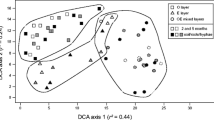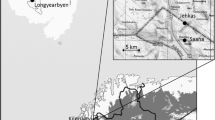Abstract
Aims
A considerable amount of information is available on root nodule formation of the nitrogen fixing actinomycete Frankia and its host plants; however, studies on Frankia populations in soil, its second ecological niche, are generally hampered by the complexity of soil systems and the lack of adequate quantification methods for frankiae. The aim of this study was, using recently developed quantitative PCR methods, to follow population dynamics of introduced Frankia strains in soil microcosms under different edaphic conditions.
Methods
Populations dynamics of four Frankia strains (ArI3, Ag45/Mut15, CcI3 and EAN1pec) representing frankiae of the Alnus host infection group (i.e. subgroups I and II infective on Alnus species, Casuarina-infective frankiae) and frankiae of the Elaeagnus host infection group, respectively, were analyzed by quantitative PCR (qPCR) in a factorial design of microcosms with two plant species (A. glutinosa, C. equisetifolia), two potential carbon resources (rhizosphere, leaf litter), and two matric potentials (wet, dry).
Results
Introduction of frankiae into soil resulted in about 10-fold declines in abundance within the first 6 weeks of incubation in both bulk and rhizosphere soils, independently of plant species, leaf litter amendment and matric potential. While this decline continued in bulk soil during an additional 6 week period, numbers in the rhizosphere recovered and increased to values close to- or exceeding those of introduced frankiae. Independently of plant species, carbon resource or matric potential, cell numbers of strain EAN1pec recovered to inoculum values in nearly all treatment combinations, while those of strain ArI3 remained low. Strain Ag45/Mut15 recovered most prominently in the rhizosphere in leaf-litter-amended microcosms, regardless of plant species and matric potential, while cell numbers of Casuarina-infective Frankia strain CcI3 recovered only in the presence of C. equisetifolia, with higher numbers in the presence of leaf litter and under dry conditions.
Conclusions
These results demonstrate differential effects of environmental conditions including plant species, carbon resources, and matric potentials on the fate of specific Frankia strains in soil, and identifies factors potentially affecting subpopulations of indigenous frankiae under natural conditions.





Similar content being viewed by others
References
Anderson MD, Ruess RW, Myrold DD, Taylor DL (2009) Host species and habitat affect nodulation by specific Frankia genotypes in two species of Alnus in interior Alaska. Oecologia 160:619–630
Anderson MD, Taylor DL, Ruess RW (2013) Phylogeny and assemblage composition of Frankia in Alnus tenuifolia nodules across a primary successional sere in interior Alaska. Mol Ecol 22:3864–3877
Bais HP, Weir TL, Perry LG, Gilroy S, Vivanco JM (2006) The role of root exudates in rhizosphere interactions with plants and other organisms. Annu Rev Plant Biol 57:233–266
Bashan Y, Puente ME, Rodriguez-Mendoza MN, Toledo G, Holguin G, Ferrera-Cerrato R, Pedrin S (1995) Survival of Azospirillum brasilense in the bulk soil and rhizosphere of 23 soil types. Appl Environ Microbiol 61:1938–1945
Benson DR, Dawson J (2007) Recent advances in the biogeography and genecology of symbiotic Frankia and its host plants. Physiol Plant 130:318–330
Benson DR, Stephens DW, Clawson ML, Silvester WB (1996) Amplification of 16S rRNA genes from Frankia strains in root nodules of Ceanothus griseus, Coriaria arborea, Coriaria plumosa, Discaria toumatou, and Purshia tridentata. Appl Environ Microbiol 62:2904–2909
Bertin C, Yang X, Weston LA (2003) The role of root exudates and allelochemicals in the rhizosphere. Plant Soil 256:83
Chaia EE, Wall LG, Huss-Danell K (2010) Life in soil by the actinorhizal root nodule endophyte Frankia. A review. Symbiosis 51:201–226
Dawson JO (1986) Actinorhizal plants: their use in forestry and agriculture. Outlook on Agric 15:202–208
Diem HG, Dommergues YR (1990) Current and potential uses and management of Casuarinaceae in the tropics and subtropics. In: Schwintzer CR, Tjepkema JD (eds) The biology of Frankia and actinorhizal plants. Academic Press, San Diego
Dobritsa SV (1998) Grouping of Frankia strains on the basis of susceptibility to antibiotics, pigment production and host specificity. Int J Syst Bacteriol 48:1265–1275
Grayston SJ, Wang SQ, Campbell CD, Edwards AC (1998) Selective influence of plant species on microbial diversity in the rhizosphere. Soil Biol Biochem 30:369–378
Meesters TM, van Genesen ST, Akkermans ADL (1985) Growth, acetylene reduction activity and localization of nitrogenase in relation to vesicle formation in Frankia strains Cc1.17 and Cp1.2. Arch Microbiol 143:137–142
Mirza BS, Welsh A, Hahn D (2007) Saprophytic growth of inoculated Frankia sp. in soil microcosms. FEMS Microbiol Ecol 62:280–289
Mirza BS, Welsh A, Rasul G, Rieder JP, Paschke MW, Hahn D (2009a) Variation in Frankia populations of the Elaeagnus host infection group in nodules of six host plant species after inoculation with soil. Microb Ecol 58:384–393
Mirza BS, Welsh AK, Hahn D (2009b) Growth of Frankia strains in leaf litter-amended soil and the rhizosphere of a non-actinorhizal plant. FEMS Microbiol Ecol 70:132–141
Nickel A, Hahn D, Zepp K, Zeyer J (1999) In situ analysis of introduced Frankia populations in root nodules of Alnus glutinosa grown under different water availability. Can J Bot 77:1231–1238
Nickel A, Pelz O, Hahn D, Saurer M, Siegwolf R, Zeyer J (2001) Effect of inoculation and leaf litter amendment on establishment of nodule-forming Frankia populations in soil. Appl Environ Microbiol 67:2603–2609
Normand P, Orso S, Cournoyer B, Jeannin P, Chapelon C, Dawson J, Evtushenko L, Misra AK (1996) Molecular phylogeny of the genus Frankia and related genera and emendation of the family Frankiaceae. Int J Syst Bacteriol 46:1–9
Poindexter JS (1981) Oligotrophy. Adv Microb Ecol 5:63–89
Rönkkö R, Smolander A, Nurmiaho-Lassila EL, Haahtela K (1993) Frankia in the rhizosphere of nonhost plants: a comparison with root-associated nitrogen-fixing Enterobacter, Klebsiella and Pseudomonas. Plant Soil 153:85–95
Samant S, Sha Q, Iyer A, Dhabekar P, Hahn D (2012) Quantification of Frankia in soils using SYBR green based qPCR. Syst Appl Microbiol 35:191–197
Samant S, Amann RI, Hahn D (2014) Evaluation of the 23S rRNA gene as target for qPCR based quantification of Frankia in soils. Syst Appl Microbiol 37:229–234
Samant S, Huo T, Dawson JO, Hahn D (2015a) Abundance and relative distribution of Frankia host infection groups under actinorhizal Alnus glutinosa and non-actinorhizal Betula nigra trees. Microb Ecol. doi:10.1007/s00248-015-0643-2
Samant SS, Dawson JO, Hahn D (2015b) Growth responses of indigenous Frankia populations to edaphic factors in actinorhizal rhizospheres. Syst Appl Microbiol 38:501–505. doi:10.1016/j.syapm.2015.07.005
Van Elsas JD, Kijkstra AF, Govaert JM, van Veen JA (1986) Survival of Pseudomonas fluorescens and Bacillus subtilis introduced into two soils of different texture in field microplots. FEMS Microbiol Ecol 38:151–160
van Veen JA, van Overbeek LS, van Elsas JD (1997) Fate and activity of microorganisms introduced into soil. MMBR 61:121–135
Welsh AK, Dawson JO, Gottfried GJ, Hahn D (2009) Diversity of Frankia in root nodules of geographically isolated Arizona alders in central Arizona (USA). Appl Environ Microbiol 75:6913–6918
Wolters DJ, Van Dijk C, Zoetendal EG, Akkermans AD (1997) Phylogenetic characterization of ineffective Frankia in Alnus glutinosa (L.) Gaertn. nodules from wetland soil inoculants. Mol Ecol 6:971–981
Zimpfer JF, Smyth CA, Dawson JO (1997) The capacity of Jamaican mine spoils, agricultural and forest soils to nodulate Myrica cerifera, Leucaena leucocephala and Casuarina cunninghamiana. Physiol Plant 99:664–672
Zimpfer JF, Igual JM, McCarty B, Smyth C, Dawson JO (2004) Casuarina cunninghamiana tissue extracts stimulate the growth of Frankia and differentially alter the growth of other soil microorganisms. J Chem Ecol 30:439–452
Acknowledgments
The authors are indebted to the Office of Sponsored Programs (Research Enhancement Program Grant No. 9000000647), the Graduate College (Doctoral Research Support Fellowship to S. Samant), and the Department of Biology at Texas State University for financial support.
Author information
Authors and Affiliations
Corresponding author
Additional information
Responsible Editor: Katharina Pawlowski.
Rights and permissions
About this article
Cite this article
Samant, S., Dawson, J.O. & Hahn, D. Growth responses of introduced Frankia strains to edaphic factors. Plant Soil 400, 123–132 (2016). https://doi.org/10.1007/s11104-015-2720-1
Received:
Accepted:
Published:
Issue Date:
DOI: https://doi.org/10.1007/s11104-015-2720-1




